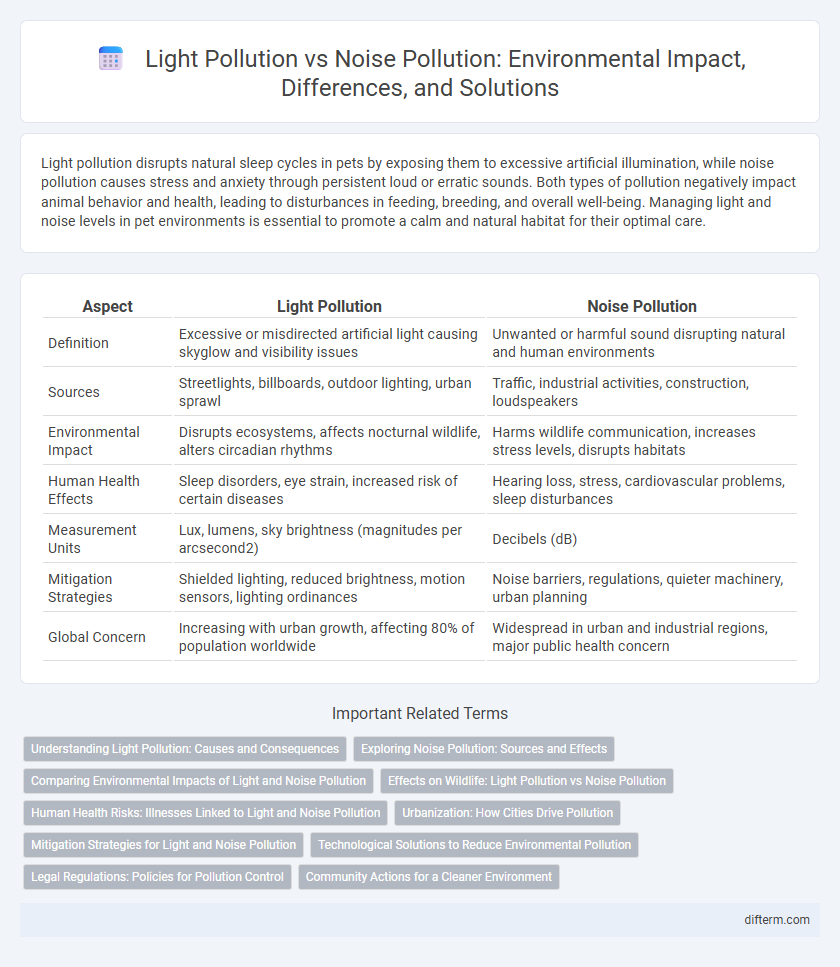Light pollution disrupts natural sleep cycles in pets by exposing them to excessive artificial illumination, while noise pollution causes stress and anxiety through persistent loud or erratic sounds. Both types of pollution negatively impact animal behavior and health, leading to disturbances in feeding, breeding, and overall well-being. Managing light and noise levels in pet environments is essential to promote a calm and natural habitat for their optimal care.
Table of Comparison
| Aspect | Light Pollution | Noise Pollution |
|---|---|---|
| Definition | Excessive or misdirected artificial light causing skyglow and visibility issues | Unwanted or harmful sound disrupting natural and human environments |
| Sources | Streetlights, billboards, outdoor lighting, urban sprawl | Traffic, industrial activities, construction, loudspeakers |
| Environmental Impact | Disrupts ecosystems, affects nocturnal wildlife, alters circadian rhythms | Harms wildlife communication, increases stress levels, disrupts habitats |
| Human Health Effects | Sleep disorders, eye strain, increased risk of certain diseases | Hearing loss, stress, cardiovascular problems, sleep disturbances |
| Measurement Units | Lux, lumens, sky brightness (magnitudes per arcsecond2) | Decibels (dB) |
| Mitigation Strategies | Shielded lighting, reduced brightness, motion sensors, lighting ordinances | Noise barriers, regulations, quieter machinery, urban planning |
| Global Concern | Increasing with urban growth, affecting 80% of population worldwide | Widespread in urban and industrial regions, major public health concern |
Understanding Light Pollution: Causes and Consequences
Light pollution primarily originates from excessive artificial lighting in urban areas, disrupting natural night environments and affecting human health by impairing circadian rhythms. Unlike noise pollution, which consists of unwanted or harmful sound vibrations, light pollution leads to ecological imbalance by disturbing nocturnal wildlife and reducing visibility of stars. Addressing light pollution requires implementing energy-efficient lighting designs and enforcing regulations to minimize unnecessary nighttime illumination.
Exploring Noise Pollution: Sources and Effects
Noise pollution, primarily generated by urban traffic, industrial operations, and construction activities, significantly disrupts human health and wildlife habitats. Chronic exposure to elevated noise levels leads to stress, hearing loss, sleep disturbances, and impaired cognitive function. Unlike light pollution, which affects visual environments, noise pollution deteriorates soundscapes, impairing communication and ecosystem balance.
Comparing Environmental Impacts of Light and Noise Pollution
Light pollution disrupts ecosystems by interfering with animal navigation, reproductive cycles, and plant growth, resulting in biodiversity loss and altered natural behaviors. Noise pollution causes chronic stress, hearing damage, and habitat displacement in wildlife, simultaneously affecting human health by increasing anxiety and cardiovascular issues. Both pollutants degrade environmental quality, but light pollution primarily alters visual ecosystems, while noise pollution impacts acoustic environments, leading to profound ecological imbalances.
Effects on Wildlife: Light Pollution vs Noise Pollution
Light pollution disrupts the natural behaviors of nocturnal wildlife by altering migration patterns, feeding habits, and reproductive cycles, leading to decreased biodiversity. Noise pollution interferes with animal communication, mating calls, and predator-prey detection, causing stress and disorientation in many species. Both types of pollution contribute significantly to habitat degradation, threatening ecosystem stability and resilience.
Human Health Risks: Illnesses Linked to Light and Noise Pollution
Light pollution disrupts circadian rhythms, contributing to sleep disorders, increased stress, and a higher risk of cardiovascular diseases. Noise pollution elevates cortisol levels, leading to chronic stress, hypertension, and hearing impairments. Both pollution types are linked to mental health issues such as anxiety and depression, amplifying overall human health risks.
Urbanization: How Cities Drive Pollution
Urbanization intensifies light pollution through excessive streetlights, billboards, and residential lighting that disrupt natural night cycles and obscure stars. Noise pollution escalates as urban centers generate constant traffic, construction, and industrial sounds, negatively impacting human health and wildlife. Together, these pollutants degrade city environments, reduce biodiversity, and challenge sustainable urban living.
Mitigation Strategies for Light and Noise Pollution
Mitigation strategies for light pollution include implementing shielded lighting fixtures, using motion sensors, and adopting warm-colored LED bulbs to minimize skyglow and glare. Noise pollution reduction involves installing sound barriers, enforcing stricter noise ordinances, and promoting green infrastructure such as vegetation buffers to absorb and deflect urban noise. Both approaches emphasize adaptive urban planning and community awareness to effectively protect environmental and public health.
Technological Solutions to Reduce Environmental Pollution
Technological solutions to reduce environmental pollution include advanced lighting systems like LED streetlights with smart sensors that minimize light pollution by directing light only where needed. Noise pollution can be mitigated using soundproofing technologies, such as acoustic barriers and noise-canceling materials, effectively reducing urban noise levels. Innovations in IoT-based environmental monitoring enable real-time data collection to optimize both light and noise management strategies in cities.
Legal Regulations: Policies for Pollution Control
Legal regulations addressing light pollution and noise pollution vary significantly, with many countries implementing specific standards to limit artificial light emissions and control decibel levels in urban environments. Policies such as the U.S. Light Pollution Control Act and the European Noise Directive establish guidelines for reducing environmental disturbances caused by excessive illumination and sound. Enforcement mechanisms often include zoning laws, curfews, and penalties designed to protect ecosystems and improve public health by mitigating these forms of pollution.
Community Actions for a Cleaner Environment
Communities addressing light pollution can implement shielded lighting and enforce curfews to reduce excessive nighttime brightness, improving local ecosystems and human health. Noise pollution control involves regulating traffic, industrial sounds, and promoting green spaces to lower ambient noise levels, creating quieter, healthier neighborhoods. Collaborative efforts between residents, policymakers, and environmental groups enhance awareness and drive sustainable practices for cleaner, livable environments.
light pollution vs noise pollution Infographic

 difterm.com
difterm.com